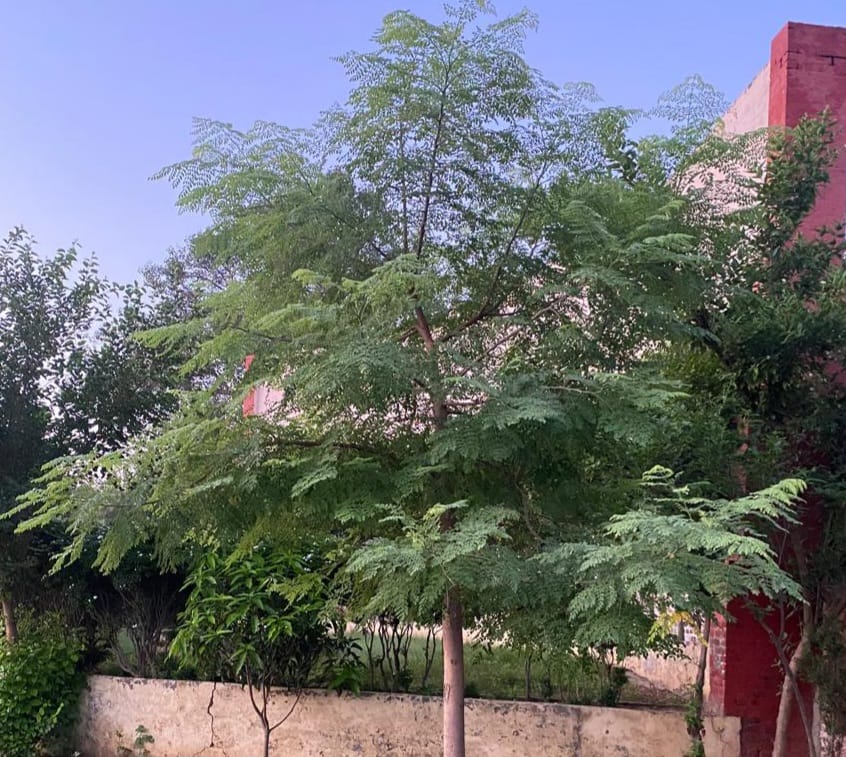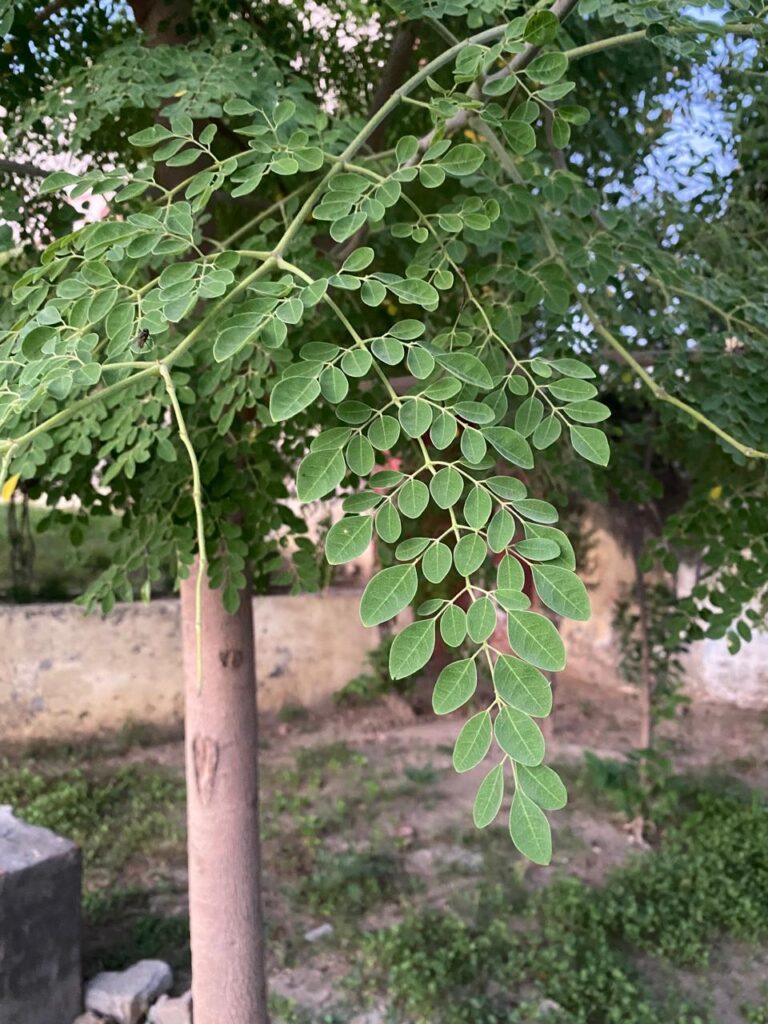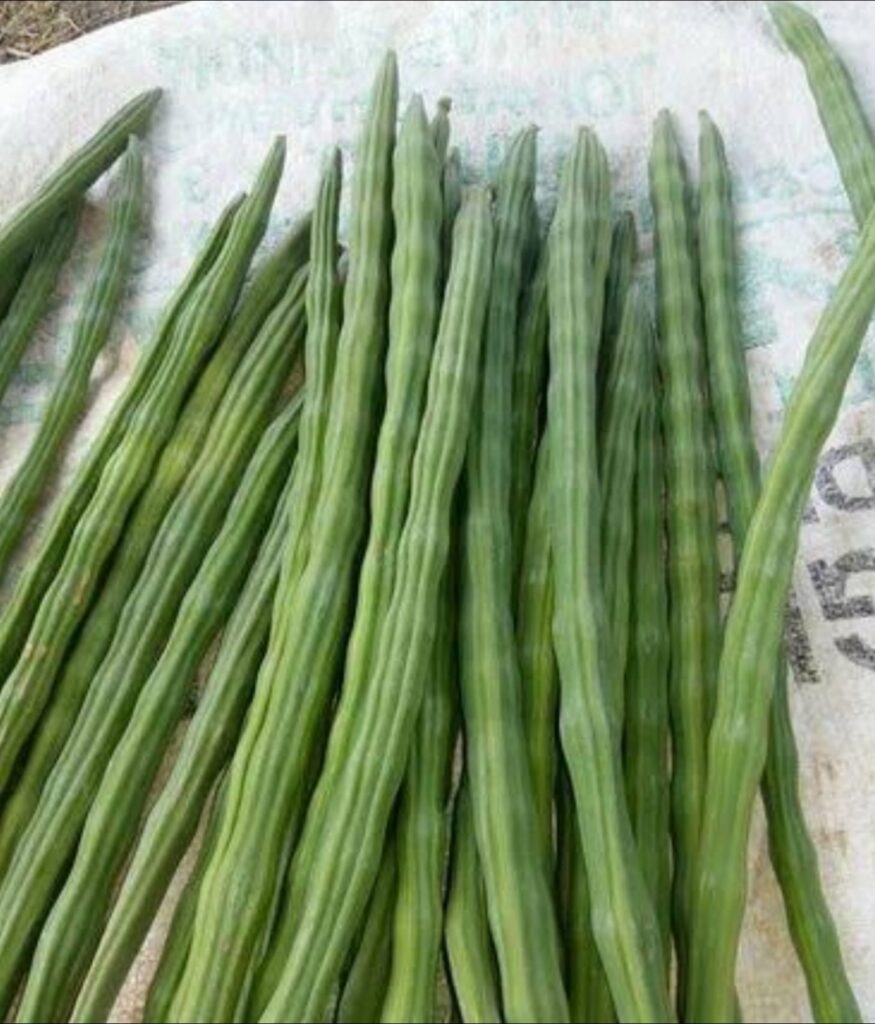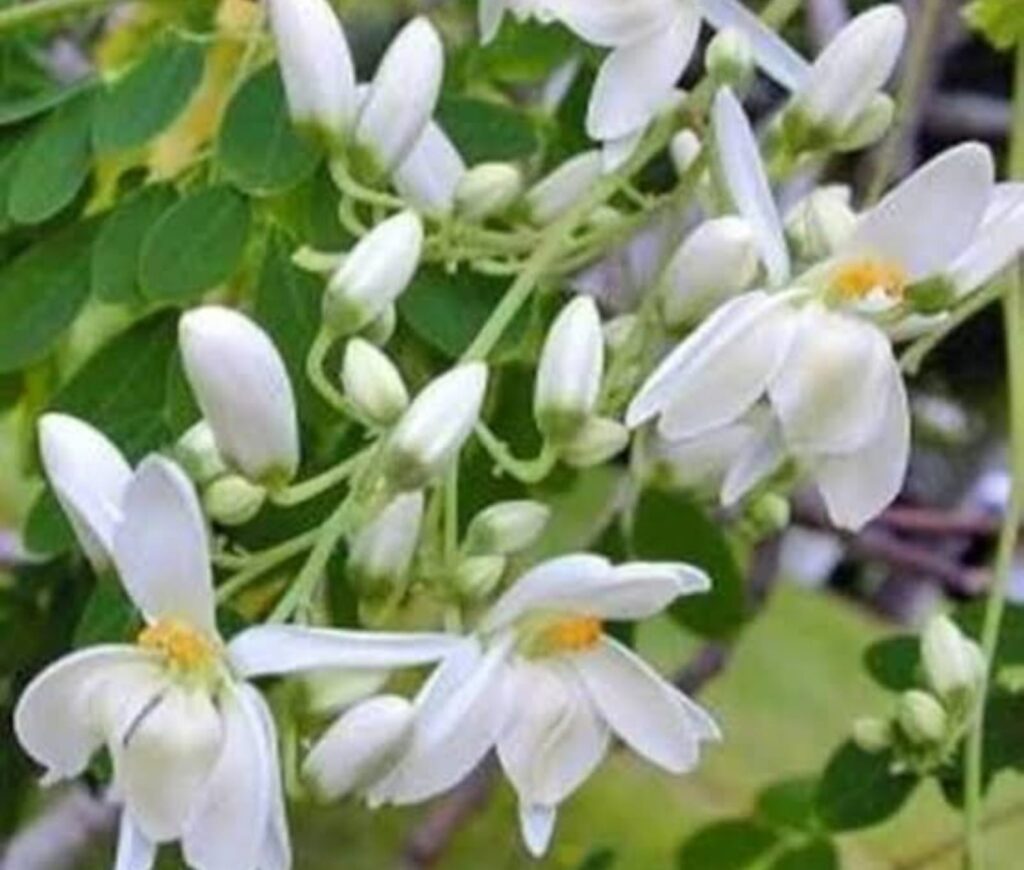ALL ABOUT MORINGA

Moringa is also known as “Drumstick tree” or “Miracle tree” or “Horseradish tree”. Its scientific name is “Moringa Oleifera”. It is also called ‘Sahjan’ in Hindi. It is a fast growing, drought resistant tree. It is native to parts of Africa and Asia. Every part of the Moringa tree-leaves, pods, seeds, roots and flowers can be used in various ways, making it a versatile resource for food, medicine and agriculture. It is known for its numerous health benefits, versatility and potential to solve food security challenges.
Edible parts of the plant include the whole leaves, fruits (called drumsticks) or pods, seeds, roots and flowers.
NUTRITIONAL BENEFITS
1. LEAVES

Nutritional profile of Moringa leaves is as follows:
Protein = 6.41 gm Vitamin D2 = 14.37 microgram Fat = 1.64 gm Vitamin E = 0.31 mg Fiber = 8.21 gm Vitamin K1 = 479 microgram Carbohydrates = 5.62 gm Calcium = 314 mg Energy = 282 kj Copper = 0.44 mg Vitamin B1 = 0.06 mg Iron = 4.56 mg Vitamin B2 = 0.45 mg Lutein = 15580 microgram Vitamin B3 = 0.82 mg Zeaxanthin = 235 microgram Vitamin B5 = 0.39 mg B- carotene = 17542 microgram Vitamin B6 = 0.87 mg Vitamin B7 = 2.26 microgram Vitamin B9 = 42.89 microgram Vitamin C = 108 mg
a) RICH IN VITAMINS
Moringa leaves are rich in vitamin B7 (biotin), vitamin A (beta-carotene), vitamin B9 (folate), vitamin C (ascorbic acid), vitamin D2 (ergocalciferol), vitamin K1 (phylloquinone).
b) RICH IN MINERALS
Moringa leaves are rich in calcium, iron, magnesium, phosphorus and zinc.
c) RICH IN AMINO ACIDS
Moringa leaves are rich in amino acids. 18 types of amino acids are found in them.
d) RICH IN ANTIOXIDANTS
Moringa leaves are rich in antioxidants like lutein, zeaxanthin, beta-carotene, vitamin C, quercetin, chlorogenic acid, thus having antioxidant properties and protect against the damaging effects of free radicals. The damage caused by free radicals is responsible for many chronic diseases like Type 2 diabetes, heart problems and Alzheimer’s. Antioxidant named Quercetin helps to lower blood pressure. Another antioxidant named chlorogenic acid helps to stabilize blood sugar levels post meals.
e) FIGHT INFLAMMATION
Moringa leaves contain anti-inflammatory compounds that can help reduce inflammation and improve overall health. Anti-inflammatory nature is due to the presence of isothiocyanates. Niazimicin, present in moringa leaves, helps in reducing cancer cells.
f) LOWER BLOOD SUGAR LEVELS IN DIABETES
Moringa leavers can stabilize blood sugar levels in diabetes because of the presence of isothiocyanates.
g) HELPS IN LOWERING CHOLSTEROL LEVELS
Moringa leaves helps in lowering cholesterol levels and protects against the risk of heart diseases.
h) GOOD FOR LIVER
Moringa leaves contain good amount of polyphenols that reduce the oxidative damage to the liver and even also repair liver cells.
i) GOOD FOR STOMACH
Moringa leaves are antimicrobial and antibiotic, therefore they are good for people having constipation, bloating, gas and other digestive disorders.
j) GOOD FOR BONES AND TEETH
Since moringa leaves are rich in calcium and phosphorus, they help in relieving pain in osteoporosis and keeps bones and teeth strong.
k) HELPS IN WEIGHT REDUCTION
Moringa leaves helps in weight reduction by increasing fat burning in the body.
l) EXCELLENT FOR SKIN AND HAIR
Due to thirty antioxidants present in moringa leaves, they are excellent for healthy skin and hair.
m) GOOD FOR NERVOUS SYSTEM
Moringa leaves are excellent for nervous system as they stabilize the production of neurotransmitters like serotonin, dopamine and noradrenaline that are important for memory, mood and for stimulus response. High concentrations of vitamin E and vitamin C reduces neural degeneration and help improve brain function.
n) DETOXIFIES
Moringa leaves are natural cleansing agents. They increase the immunity and energy levels in the body.
2. PODS (DRUMSTICKS)

Nutritional composition of Drumstick is as follows:-
Protein = 2.62 gm Vitamin E = 0.31 mg Fat = 0.12 gm Vitamin K1 = 358 microgram Fiber = 6.83 gm Lutein = 145 microgram Carbohydrates = 3.76 gm Zeaxanthin = 5.52 microgram Energy = 123 kj Beta carotene = 17.28 microgram Vitamin B1 = 0.04 mg Calcium = 33.3 mg Vitamin B2 = 0.07 mg Copper = 0.10 mg Vitamin B3 = 0.62 mg Iron = 0.73 mg Vitamin B5 = 0.57 mg Vitamin B6 = 0.12 mg Vitamin B7 = 4.29 microgram Vitamin B9 = 62.75 microgram Vitamin C = 71.86 microgram Vitamin D2 = 1.67 microgram
a) RICH IN VITAMINS AND MINERALS
Moringa pods are excellent source of vitamin C, vitamin A, calcium, potassium, vitamin B7, vitamin B9 which improves immunity, health and bone strength.
b) HIGH IN FIBER
The drumsticks are rich in dietary fiber, aid digestion, prevent constipation and promote a healthy gut.
c) LOW IN CALORIES
d) GOOD SOURCE OF ANTIOXIDANTS
They contain lots of antioxidants like lutein, zeaxanthin, quercetin that protect from oxidative stress and reduce inflammation.
e) REDUCE BLOOD SUGAR LEVELS
f) ANTI INFLAMMATORY PROPERTIES
Anti inflammatory properties of drumsticks help to reduce the risk of chronic diseases.
g) Drumsticks are commonly used in Indian cuisines, especially in dishes like sambhar.
3. SEEDS

a) Moringa seeds are rich in oil, that can be used for cooking.
b) Oil from moringa leaves can also be applied topically.
c) Moringa seeds also have water purifying properties.
d) They can be eaten like peas or can be roasted and consumed as a snack.
e) They can be used as a natural food coloring agent.
4. FLOWERS

a) Moringa flowers are rich in vitamin A, vitamin C, vitamin E, calcium, iron and potassium.
b) Moringa flowers are rich in antioxidants that helps protect against cell damage and oxidative stress.
c) They have anti inflammatory properties that help reduce inflammation and improve overall health.
d) Moringa flowers reduce blood pressure and improve cardiovascular health.
e) Moringa flowers may improve insulin sensitivity and help regulate blood sugar levels.
f) They reduce eye inflammation and may help protect against age related muscular degeneration due to high content of antioxidants.
g) They contain compounds that may have anti cancer properties.
h) They improve immunity due to high vitamin and mineral content.
i) Moringa flowers may help improve memory and cognitive function.
j) Moringa flowers have been traditionally used to reduce menstrual cramps and other symptoms of PMS.
k) Moringa flowers may help regulate digestion and reduce symptoms of bloating and gas.
l) Moringa flowers may have anti bacterial properties.
MORINGA IN TRADITIONAL MEDICINE
Moringa has been used traditionally in Ayurveda since ages. According to Ayurveda:-
a) Moringa balances the body’s doshas.
b) It is used to treat various problems like digestive issues, skin problems and respiratory conditions.
MORINGA IN MODERN MEDICINE
Research is still ongoing to study the potential uses of moringa in treating conditions like cancer, diabetes, arthritis.
IMPACT OF MORINGA ON ENVIRONMENT
a) Moringa trees are drought resistant and can grow in poor soil.
b) They are excellent crop for regions facing food insecurity.
PRECAUTIONS WHILE USING MORINGA
a) Moringa is generally safe in moderate amounts. But consuming large amounts of its roots and bark can be harmful due to potentially toxic compounds.
b) Pregnant women should not consume moringa bark and roots as they may have stimulant effects.
In conclusion, Moringa is a plant of great importance due to its diverse applications in food, ayurveda, health and medicine industry. Its importance become manifold especially in regions where food and nutritional security are critical. Nowadays, people have started recognizing the importance of moringa as a superfood and medicinal plant. However further research and responsible cultivation practices are necessary to fully harness its benefits.
For individualized and customized diet plans, CONTACT:
Neena’s Diet Clinic Dietician Neena Mscdfsm Course in low FODMAP diet for IBS from Monash University, Australia Life member of IDA
« IMPORTANCE OF BALANCED DIET OVER HIGH PROTEIN DIET | WORLD MENTAL HEALTH DAY »